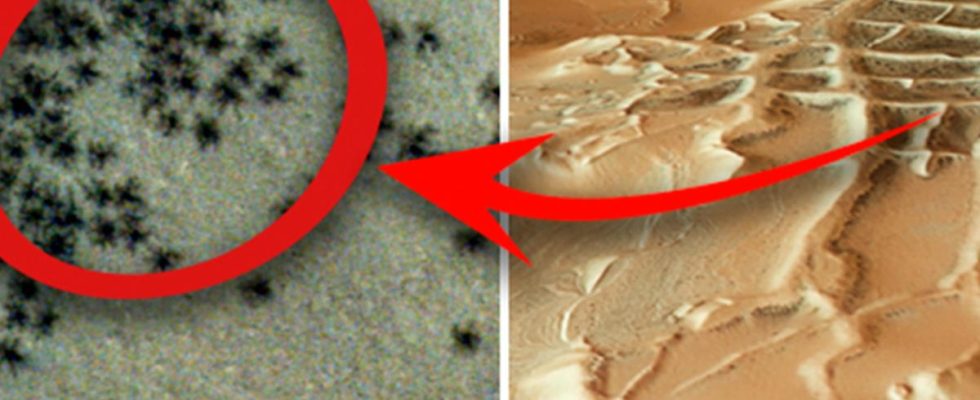Updated 00.42 | Published 00.42
unsaveSave
expand-left
full screen In the mysterious “Inca City” the “spiders” were found Photo: Esa/Tgo/Cassis
The Swedish Space Agency searched for life on Mars.
They found huge “space spiders” – in the planet’s mysterious “Inkastad”.
Now ESA has given its explanation for the phenomenon of the spider pictures that have been spread online.
Is the planet Mars full of giant spiders? In images released by the European Space Agency ESA, it can undeniably look that way. It is one of ESA’s Mars Express satellites that photographed the planet, which is the fourth planet from the sun in our solar system.
The photographs show black dots with thin spreading lines, like spiders’ legs, protruding in different directions against the light background.
According to a press release from ESA, the shapes on the “red planet” arise when the sun shines on the carbon dioxide that Mars deposited during the winter months.
800 meters wide
Now, however, spring reigns on Mars and the light causes the carbon dioxide ice, at the bottom of the deposits, to turn into gas.
The gas eventually breaks through the ice, which can be up to one meter thick, and ejects dust in geyser-like explosions that then settle on the surface of the ice, the space agency says.
And the spider forms on Mars are far from spider-sized. According to ESA, the smallest are 44 meters wide, while the largest can be more than 800 meters in diameter.
“Unearthly Phenomenon”
Their spider shape is carved into the surface of Mars under the carbon dioxide ice, the Swedish Space Agency states.
– The carbon dioxide process that forms “spiders” is a completely unearthly phenomenon, says Meg Schwamb, astronomer at Queen’s University in Belfast, UK, to Daily Mail.
– The jet process is linked to the seasons of Mars and returns carbon dioxide to the atmosphere. By studying these spiders and jets, we learn more about how Mars differs from Earth.
expand-left
full screen The Swedish Space Agency found huge “space spiders” on Mars. Photo: Esa/Tgo/Cassis
March Machu Picchu
The “spiders” were first observed back in 2016 by a spacecraft searching for life on Mars. Most of the dark spots were then seen at the edge of a part of the planet nicknamed the “Inca City” – because of its “linear, almost geometric network of ridges”.
These, ESA believes, are reminiscent of the ruins of the Incas, of which Machu Picchu in Peru is perhaps the most famous example.
The “Inca City”, which was discovered by a NASA probe back in 1972, also known as “Angustus Labyrinthus” is located near the planet’s south polar mass.
According to ESA, it is unclear how the area got its patterns. One theory is that they are sand dunes that have turned to stone over time. Another is that a material such as magma or sand seeped through rock.
FACTS The Martian spiders
They are called “araneiforms” or “spiders” and are different phenomena carved into the surface of Mars in the southern polar regions.
Researchers at ESA believe that the phenomenon occurs in the spring, when sunlight passes through and heats up a layer of carbon dioxide ice that formed during the winter.
The heat causes gas to form under the ice and shoot up through cracks in it, like a geyser, and then settle on the surface.
Because the gas being pushed up is filled with dark dust, dark shapes form that have been likened to spiders.
This does not happen anywhere on earth, states ESA.
Read more
